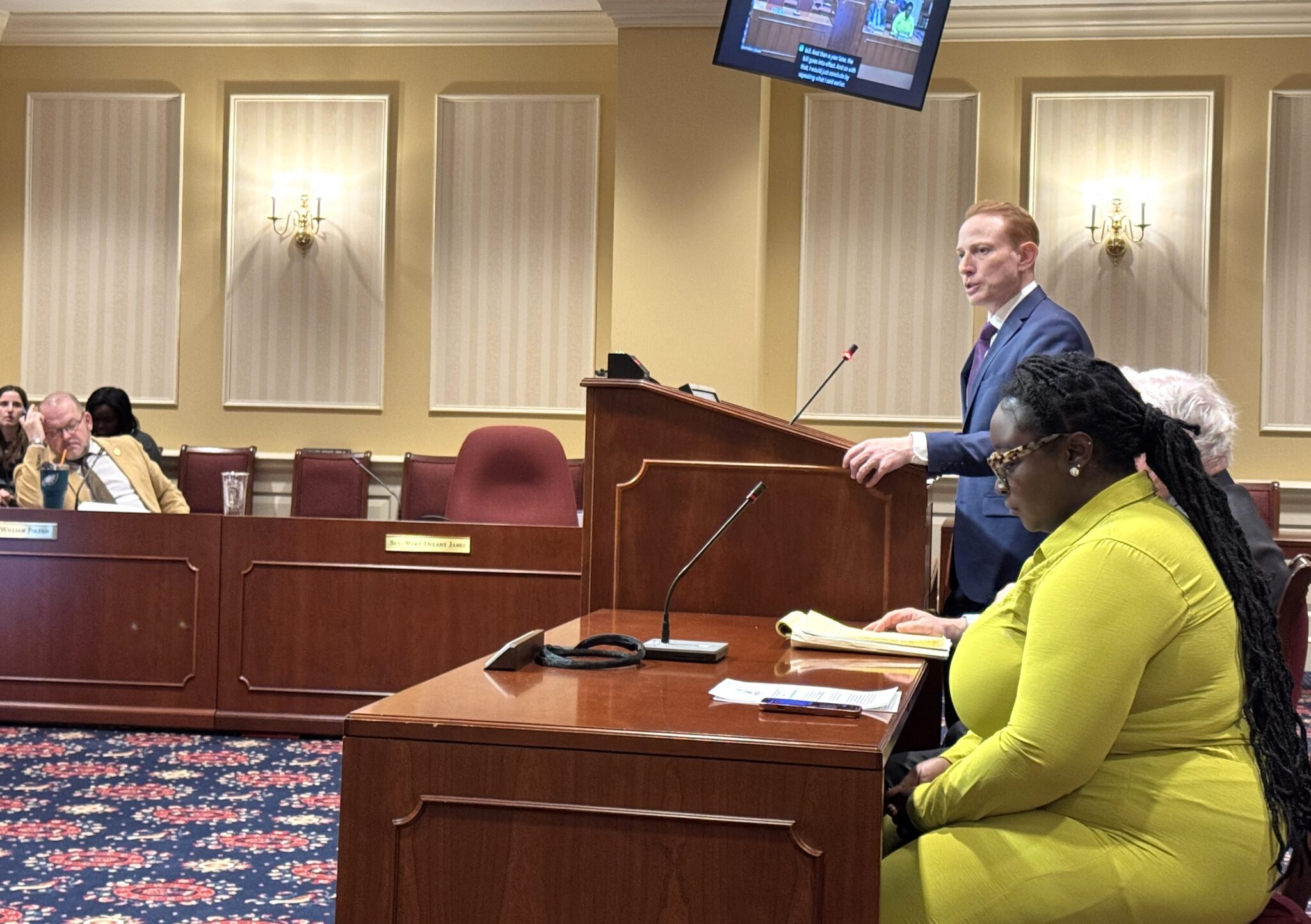Gov. Wes Moore (D) said Tuesday he will avoid tax increases and massive budget cuts and instead focus on growing the state’s economy to solve the worst budget problem in more than two decades.
Moore spent much of the day teasing the release Wednesday of his fiscal 2026 budget proposal, which he is billing as a solution to the state’s budget woes that will also reduce taxes and spur economic growth.
“Anyone who simply thinks you can tax your way to prosperity doesn’t know what they’re talking about,” Moore said Wednesday during a speech at the University of Maryland, College Park. “Anyone who also thinks you can cut your way to prosperity does not know what they’re talking about either. The answer is as a state we need to grow.”
Maryland faces a $3 billion budget gap for fiscal 2026. That’s on top of a $300 million shortfall in the current year. In five years, legislative analysts project a structural deficit exceeding $6 billion for the state government. Moore is scheduled to release his proposed spending plan before noon Wednesday, after a breakfast meeting with lawmakers.
At a conference sponsored Tuesday morning in Annapolis by The Baltimore Banner, Moore touted elements of his budget proposal without offering many specifics, and also sought to tamp down potential criticism.
“I’m not sure what issue people have with the plan when they haven’t seen it yet,” he said.
Moore said his budget proposal would include tax cuts for about two-thirds of all Marylanders, and no sales tax or property tax increases. This would be noteworthy, he said, whether it was coming from a Democratic or a Republican governor.
He characterized the cuts as a reform of the tax code that will be “simpler, fairer and for the vast majority of Marylanders, lower.” Moore said “82% of Marylanders” will get a tax cut or see no changes in their taxes at all.
Analysis: Moore’s delicate balance as the session gets under way
The cuts proposed by the governor represent a reduction in state revenues on top of the projected deficit. Moore did not say how he would immediately offset those proposed reductions.
“At the end of the day we still have to bring in more than we spend,” said Senate Budget and Taxation Committee Chair Sen. Guy Guzzone (D-Howard) on Tuesday. But he added that, “Until I have it (the budget) all in front of me, I’m not going to pass judgment.”
House leaders so far have had little to say about the budget. It’s clear Moore will have to make the case for his plan to them.
Moore also suggested Tuesday morning that his budget would reduce state spending for the third year in a row — unheard of for a Democrat, he said — and added that his budget plan emphasized economic growth as a way to close future projected gaps in state revenues.
“I think the piece of news is the growth agenda, that Maryland finally has a growth agenda,” he said.
Without mentioning him by name, Moore blamed his predecessor, former Gov. Larry Hogan (R), for a sluggish economy, and said any notion that Hogan had a structural surplus when he left office belied the fact that state revenues had been bolstered by robust federal spending during and immediately after the pandemic.
“There has never been a structural surplus,” Moore said. “DLS [the Department of Legislative Services] has been projecting a structural deficit since 2017.”
U.S. Rep. Andy Harris (R-1st), who was in Annapolis Tuesday, took issue with Moore’s diagnosis of the state’s fiscal condition.
“The Maryland General Assembly has been spending its way into oblivion for the past decade,” he said.
Asked whether he would dip into the Rainy Day Fund to balance his proposed budget, Moore did not answer directly.
“I think us having and maintaining a healthy Rainy Day Fund is important,” he said. “If people think this is a moment to raid the Rainy Day Fund, they’re sorely mistaken.”
Moore also vowed to protect the Blueprint for Maryland’s Future, the sweeping and costly education reform plan.
“Any idea that we’re going to eliminate the Blueprint — let me make it clear: Not on my watch,” he said.
But the governor conceded that “adjustments” might be necessary to sustain the plan, and said contemplating such moves was not unusual. The Social Security system has been tweaked 17 times, he noted, while the Maryland Constitution has been updated about 200 times.
Moore added that his top short-term priority for the Blueprint was confronting the state’s “shortage of tens of thousands of certified teachers.”
The governor may face some resistance. House Democrats staked out a “high bar” standard of their own for modifying the Blueprint plan.
Since the start of the legislative session, Moore has doled out details of his spending plan in dribs and drabs. So far, the discussions have been promise-rich and detail-poor.
That will change Wednesday when the governor’s budget is sent to lawmakers and released to the public.
On Tuesday, the governor announced plans to cut personal and corporate taxes while solving the fiscal crisis, making key economic investments and balancing the budget as required by law.
“Maryland, if we grow, we win,” he said during the Tuesday afternoon event at the University of Maryland, College Park. “And we’re going to grow.”
It is unclear how quickly Moore’s plan — if passed unaltered — would result in economic growth.
“We’ve got to invest in industries we know are going to help us win the decade because in 2030, I want us to look back and see a state that finally applied itself,” Moore said.
“I want us to look back and see a state that finally applied a strategy to economic development,” he said. “In 2030, I want to look back and see an economy that grew faster than anyone expected. In 2030, I want us to look back and see good-paying jobs in leading industries of the future.”
Moore is promising hundreds of millions in government spending he said would spur economic growth in the state. Included in that is $750 million earmarked for economic and workforce development.
Another $128 million would be focused on strengthening the state’s regional economic competitiveness, Moore said. Nearly $28 million would go to a quantum computing joint venture between IonQ, the state and University of Maryland.
Moore said that $128 million would generate $515 million in economic activity and create 2,300 jobs. Those jobs would result in $210 million in income, he said.
GOP backs cuts to entitlements, opposes tax and fee increases
It is unclear how the governor’s tax cut proposals will be received in the legislature.
Some Democrats in the House who backed tax increases a year ago have taken an almost “I told you so” stance, even as Senate leaders maintain there is a ‘high bar” for such increases.
The governor said his spending plan will include $2 billion in cuts and efficiencies, but none of the reductions or savings that have been publicly identified so far would make much of a dent in the projected deficit.
Moore eschewed across the board reductions calling them “lazy.” Instead, Moore said he favors more nuanced cuts.
“I think any conversation around revenues is going to be a challenging one,” Senate President Bill Ferguson (D-Baltimore City) told reporters Tuesday morning. “Generally. I think there is a lot of hesitation in the current economic climate. We are very sensitive to changing prices or increasing prices, and to Marylanders’ feelings about the cost of living in Maryland.
“That said, we also know that I care and members care about our values, about making sure we can provide great health care systems and provide a great public education. Any discussion is going to be challenging, but it is not off the table,” he said of revenues. “We will take the governor’s proposal and review it seriously.”
by Bryan P. Sears and Josh Kurtz, Maryland Matters
January 14, 2025
Maryland Matters is part of States Newsroom, a nonprofit news network supported by grants and a coalition of donors as a 501c(3) public charity. Maryland Matters maintains editorial independence. Contact Editor Steve Crane for questions: [email protected].






















